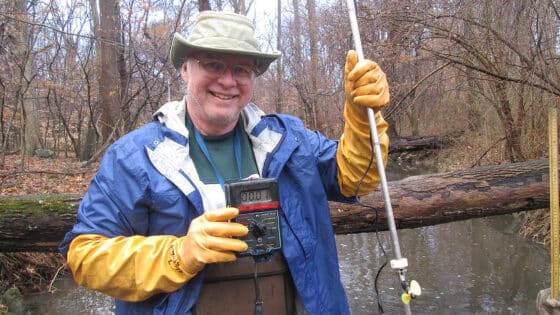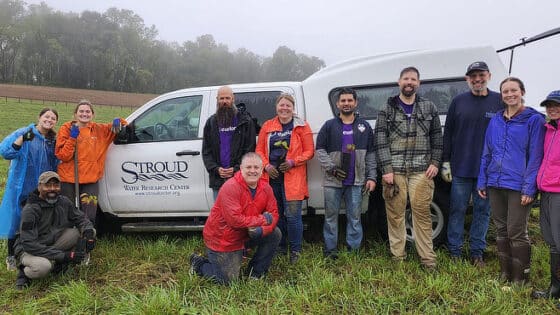Stroud Scientists at Work
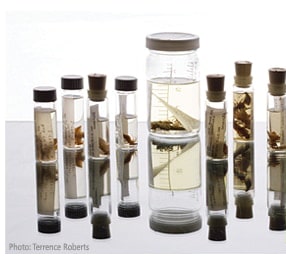
IBOL: A Revolutionary Step Forward in Assessing and Addressing the Health of the Planet
Imagine cheaply, rapidly and accurately cataloging all the species of the world by genetic barcode. This immense undertaking, being driven now by the International Bar Code of Life (iBOL) project, has the potential to not only revolutionize research — but to affect public policy for pest and disease control, food safety, resource management and conservation, education and even recreation.
It’s an immense and important global project, with the commitment of a consortium of 25 countries to date, which will impact virtually every area where human populations interact with the world’s species. And Bernard Sweeney, senior research scientist and director of the Stroud Water Research Center has been asked to play a critical role as its Freshwater Bio-Surveillance work group leader.
THE INTERNATIONAL BAR CODE OF LIFE PROJECT
The International Bar Code of Life (iBOL) project has overarching goals to both assemble a DNA sequence library of the world’s species and, create the technology to rapidly and inexpensively identify organisms. Cataloging species using this universal, digital codification system will help refine taxonomic systems, provide new insights about species and, no doubt, generate many new questions worthy of scientific investigation.
The consortium hopes to institute ongoing, standardized identification and regular biotic monitoring that will answer critical questions related to food-web ecology, ecosystem integrity, and resilience to changes in climate — in effect, providing the tools to immediately assess the health of our planet — a necessary step if we are to put into place measures to protect it.
The organization’s immediate goal is to expand the current global catalog of 40,000 species and 400,000 specimens to upwards of 500,000 species and 5,000,000 specimens within 5 years. To do this will require great manpower and expertise as the Barcode Library will include the surveys of 10 target organism assemblages or environments, including: vertebrates, land plants, fungi, human pathogens and zoonoses, agricultural and forestry pests and their parasitoids, pollinators, marine and freshwater organisms.
A PRIORITY: THE FRESHWATER BIOSURVEILLANCE WORKGROUP
The importance of the freshwater bio-surveillance group is three-fold. The International Barcode of Life project has prioritized this group because 1) freshwater species are the most threatened by human activity including dams, habitat destruction, and pollution, 2) species, such as fish, are of particular socio-economic importance, and 3) and certain groups of freshwater organisms (among them: caddisflies, mayflies and stoneflies) are used worldwide by scientists to assess water quality.
The promise of iBOL and the work of the Freshwater Surveillance group is far reaching,” said Paul Hebert, Integrative Biology Professor at the University of Guelph, Canada and Scientific Director of iBOL. “We have an opportunity to make huge strides in both characterizing the world’s biodiversity and in finding real utility in that knowledge. Sweeney’s appointment to help lead the Freshwater Surveillance group represents an essential step towards attaining these goals.”

AN INTERVIEW WITH BERN SWEENEY
What was it that prompted this appointment?
The Stroud Water Research Center’s work using barcode technology to identify pollution-sensitive mayflies, stoneflies, and caddisflies, and our decades-long experience in freshwater research positioned us well for some kind of involvement in this global effort. But, I’m particularly grateful to Dan Janzen, our friend and colleague at the University of Pennsylvania, and one of the foremost evolutionary ecologists in the world, for his recommendation on my behalf. This is groundbreaking work and the success of our efforts will vastly improve our ability to protect freshwater resources everywhere.
What is your first priority for the group?
Our initial concentration will be on North America, working to create a freshwater “library of life” based first on museum collections of invertebrates most widely used for water quality assessment. The group will then compare the results of water quality assessments based on course identifications with those based on species-level data. Our hope is that these pilot studies will validate the benefits of identification based on DNA barcoding and help solidify the required funding to take the program to Phase II and the rest of the world. If we’re successful, then the rapid, accurate, and precise biotic monitoring this program enables will ensure more effective protection, restoration, and remediation efforts of all of our freshwater resources.
How will this impact your role at Stroud Water Research Center?
When I think of the potential for new relationships, collaborations, and the data this will produce, it can only benefit the Center. I’ll be part of an elite group of scientists and a consortium of 25 countries with the common goal to revolutionize our ability to understand and monitor the world’s biodiversity — and that has huge implications for freshwater quality. Happily, this role is closely aligned with my scientific goals here at the Center. It allows me to continue in my current role as Director of the Stroud Water Research Center, while pursuing my passion — scientific research in the area of aquatic ecology.
Stroud Research Sheds New Light on the Impact of Temperature Change in Large Rivers
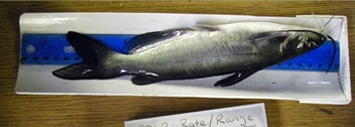
PPL Corporation, an energy company that operates power plants in the Northeast and Northwest, recently funded a first-of-its-kind, site-specific research study to simulate the effects — and understand the impact — of rapid daily changes of temperature in the Susquehanna River on its fish and macroinvertebrate populations. The study, which was conducted by the Stroud Water Research Center, fills a void of empirical data on the impact of rapid changes of temperature on river ecosystems. PPL Corporation hopes the research will also underscore its desire for science-based regulations that are protective of aquatic life.
Investments in environmental controls by the company over the last four years at its Brunner Island power plant in York County, Pa., have totaled $800 million. Brunner Island is a three-unit, coal-fired generating plant on the Susquehanna River that was built in the 1960s. The plant generates enough electricity each year to power about 1 million typical homes. The recent environmental upgrades at the Brunner Island plant include the installation of mechanical-draft cooling towers. Work on the $125 million cooling tower project began last year and will be completed in 2010. This overall investment, says PPL, demonstrates PPL’s commitment to the environment while better serving its customers and shareholders by providing the most cost-efficient generation of power.
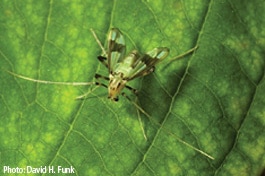
FILLING THE EMPIRICAL VOID
To better understand the extent of environmental controls needed to protect a river’s macroinvertebrate and fish populations from undue stress related to temperature changes associated with warm water discharges from power plant operations, PPL Corporation asked the Stroud Water Research Center to conduct a site-specific study on a representative set of aquatic organisms that live in the Susquehanna River and its tributaries in the vicinity of the Brunner Island power plant.
Chapter 93.7 of the Pennsylvania Code sets forth specific water-quality criteria for the state, including the permissible rate of temperature change per hour that can be caused by human activity on state surface waters. Pennsylvania law currently limits the rate of hourly change to 2 degrees Fahrenheit or less. Because power plants regularly discharge artificially heated and cooled water as a byproduct of electricity generation, it’s not surprising that a power company would be interested in the scientific basis for this regulation.
“Essentially PPL rolled the dice,” said Bern Sweeney, director of the Stroud Water Research Center and principal investigator for the study. “Our reputation for science without bias required that we enter into this relationship only if we could publish the results — regardless of outcome.”
PPL didn’t hesitate. “The Stroud Water Research Center’s scientific credentials, independent status, and impeccable reputation for detail were key factors in our company’s choice of the Center to conduct this much-needed study,” said Nancy Evans, senior environmental professional and coordinator of the project for PPL. Tinku Khanwalkar, PPL’s Senior Director of Environmental Management, concurred adding, “We’re not aware of a more detailed study anywhere, by any industry and we think the data have broad-based applicability.”
OVERCOMING CHALLENGES IN THE PURSUIT OF SCIENCE
The complex study took six months to design. The first challenge for Stroud scientists was to come up with a theoretical construct that would allow them to isolate the rate of temperature change from all other thermal effects — no small task.
“We had to distinguish the effects of rate of change from everything else related to temperature, including duration, magnitude, and temperature thresholds,” said Sweeney, “and that was just the first of our hurdles.”
The research team then had to design and build the systems that could reliably produce rapid (up to 8 degrees Fahrenheit per hour) temperature changes with the precision of one tenth of a degree Fahrenheit — a challenge that required extensive mechanical engineering and software development and a feat that, to their knowledge, had never been done before for a river study.
The final challenge was the sheer magnitude of the effort required to rear the species needed for the study. Stroud scientists raised more than 4,000 fish, hatched and reared 10,000 or more aquatic insect eggs and larvae, and had to feed all of them each day with carefully measured amounts of home grown algae, disease free fish, or a special mix of dry food depending on the insect or fish. “This is the first time anyone has applied whole life-cycle testing to twelve different species of stream insects in one study,” said Sweeney. “The husbandry effort alone was huge. Moreover, every fish had to be individually tracked, measured, and evaluated for primary, secondary, and tertiary stress responses throughout the study.”
UNDERSTANDING SUBLETHAL STRESS TOLERANCES OF FISHES
Seven species of fish were involved in the study, which evaluated rates of temperature change between 1.5 and 8 degrees Fahrenheit per hour day after day under both summer and winter conditions. The study focused on fishes common to the Susquehanna River — including predators (Smallmouth Bass and Walleye), bottom feeders (Channel Catfish and White Suckers), and foragers (Bluntnose Minnow, Spotfin Shiner and Rosyside Dace).
“Not much is known about how short term rates of temperature change affects fish, so we designed our experiment to look at as many responses as possible — from blood-based changes to changes affecting individual organs to overall survivorship,” said Willy Eldridge, who heads the Center’s Fish Molecular Ecology department. “We looked at muscles, skin, brain — every individual organ from the gills and heart to the liver, kidney and spleen.…We even studied the bones and cartilage.”
A key element of the study focused on growth and survivorship of each species to determine any long-term effects. The research also looked at immediate and short-term indicators of stress, including glucose and cortisol levels. Finally, to validate the results, Stroud scientists relied on histopathology (the microscopic examination of tissue), which was conducted by Dr. Mac Law, an American College of Veterinary Pathology (ACVP) board certified veterinary pathologist at the North Carolina State University College of Veterinary Medicine.
“We had no preconceived notions about the outcome,” Eldridge said. “What we found was encouraging, as we saw few signs of stress even at the extreme daily temperature changes. Because of our intense evaluation of a broad suite of study parameters, we’re confident in the results.”
ASSESSING THE IMPACT ON AQUATIC INSECT COMMUNITIES
In addition to the fish studies, Stroud scientists tested for thermal impacts over the full life cycle of twelve mayfly species. Mayflies are an important indicator of water quality due to their sensitivity to environmental disturbance, and the scientists looked at everything from embryonic development to larval survivorship, from larval metabolism and growth rates to adult size and egg production. They even studied “larval drift” — a behavioral tactic to avoid predators, which could also indicate thermal stress.
“The bottom line was the same for the insects as for the fish,” said Stroud entomologist John Jackson.
Because of the ground-breaking work achieved by the Stroud scientists, a scientific void has been filled, allowing the State and the private sector to work together to apply resources where they benefit the environment the most.
Stroud Educators at Work
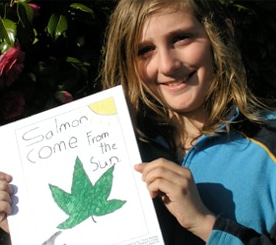
Leaf Pack: Linking Kids to their Environment and Community
Forest Grove Community School is a special place — a public charter school in Oregon where student projects are connected to both community and place, and where hands-on experience is considered the best way to learn. In this kind of environment, it’s not surprising that a group of fourth, fifth and sixth graders equipped with the Leaf Pack Experiment Kit could have an impact on a community — or that nine to twelve year old kids could be enthralled by nature and connected to their environment, at a time when “nature deficit disorder” has become a part of the daily lexicon.
Charlie Graham teaches all subjects, The Leaf Pack Experiment Kit makes identifying macroinvertebrates easy. By all accounts he’s no ordinary teacher. After 20-years in the public school system, his enthusiasm for this charter school and his students is palpable. He takes his job seriously and gets genuine enjoyment from watching his students connect the dots and understand their relationship to the environment. So, it’s no wonder that he is a fan of the Leaf Pack Experiment Kit. “I love that it provides an authentic learning experience,” he said, “and exposes my students directly to the scientific process.” An added benefit is the validation that comes with uploading and sharing data with other schools around the world through the web-based Leaf Pack Network®.
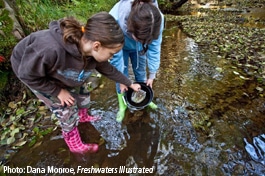
Listening to Graham share the vision for his latest Leaf Pack project — a partnership with local sustainable timber company Hyla Woods, which seeks to prove that logging practices can be both sustainable and profitable — peeked our curiosity.
Hyla Woods has been in business for generations. Situated 40 miles west of Portland in the North Oregon Coast Range and the nearby town of Vernonia, the land on which it sits and the community surrounding it experienced problems as a result of two so-called 100-year floods in 11 years — the first in 1996 and another in December of 2007. These events had a devastating impact on the local community — wiping out schools, disrupting basic services, damaging homes and the local freshwater ecosystem. Hyla Woods, in cooperation with the Watershed Council, conservation non-profits, local businesses, universities and schools, worked to restore and enhance the ecological diversity of the creek and surrounding forests — building upon work the timber company had begun in 1986, long before the floods occurred.
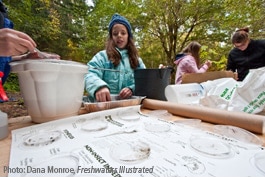
MONITORING THE HEALTH OF LOUSIGNONT CREEK
Charlie Graham and Hyla Woods proprietor, Peter Hayes, decided to take the reforestation project one step further — bringing the classroom out of doors, and enabling local students to engage in a long-term scientific experiment to monitor Lousignont Creek, one of the headwaters of the Nehalem, which runs directly through Hyla Woods and is important habitat for coho salmon, steelhead, and the species on which they depend. Students are testing the hypothesis that improving the streamside forest and conducting sustainable logging practices, will yield a healthier river ecosystem with tangible benefits to both the natural ecosystem and the hard-hit community. Said Hayes of the partnership, “This cooperation provides a good opportunity to reach the twin goals of educating and energizing kids and enhancing community health through a single action.”
Peter Hayes, a conservationist and educator himself, has been a tremendous advocate of the program. It seems a perfect fit with his family-owned business which operates three Forest Stewardship Council (FSC) certified forests in the northern Oregon Coast Range. The company monitors and guides its sustainability efforts by tracking its impact on the forest with annual bird counts, which it recently expanded to include indicators focused on amphibians, water temperatures, and macroinvertebrates.
SHARING THE RESULTS
Hayes joined the kids in the fall of 2008 in the Lousignont as they conducted their first Leaf Pack experiments and collected macroinvertebrate data as an indicator of creek health. Students have continued their efforts with another visit to Hyla Woods this spring and they will compare the new data with the baseline data they’ve already established, as well as with future data collected over the next several years.
“The Leaf Pack Tool is a manageable way for teachers and students to help us answer an important question — namely, is the creek healthy,” said Hayes, noting that, “Leaf Pack is helping students reach essential educational goals by doing real and important work.” And that, in addition to spending a day in the woods, was what really excited 11-year old, Nathaniel Torry-Schrag, known by his friends as Natty. “I just love the outdoors, and the fact that we were helping someone take water quality measurements made it seem like we had more of a purpose. I definitely thought it was a lot of fun,” said this 5th grader and author of Salmon Come from the Sun, a book about the Hyla Woods project and the Leaf Pack experiment.
Forest Grove Community School students’ data will be blended with the data of other researchers from Oregon State University and Oregon’s Department of Environmental Quality to create an overall picture of creek health — and the results will be visible to all.
Events
The Water’s Edge: Your Ticket to the Exotic Lord Howe Island
LIVING IN PARADISE

It’s a privileged few who can call Lord Howe Island home. A spit of land just 7 miles long and 1 mile wide and a UNESCO World Heritage Site off the coast of Australia, the island is a two-hour flight by prop plane from the mainland. Its isolation, the foresight of the Australian government, and active conservation management have ensured that “the island remains much the same as it was for thousands of years,” says Ian Hutton, one of only 300 people who live in this paradise, and the guest speaker for our annual fundraising gala, The Water’s Edge, on October 8th, 2009. Hutton, the authority on the flora and fauna of the island, will present The Pristine Lord Howe Island: Conservation Management at its Best.
Remarkably, Hutton’s residency and his intimate knowledge of this remote and exotic place were the result of serendipity. Always interested in nature, Hutton is a Boy Scout turned biologist with a degree in plant ecology. His background and a bit of the wanderlust led him to a career with the Australian weather bureau a vocation that turned out to be perfect for a young man who loved to travel, as the job took him all over Australia, a country rich with diverse ecosystems and climates. One day a posting for a ‘weather observer’ on Lord Howe Island caught his eye. It seemed, he says, the perfect spot and the perfect job, providing lots of free time to explore and photograph the island. In his new role, he could spend much of his time climbing the island’s rain forests, studying its coral reefs, plants and bird life and learning about a place that few people will ever get to see. “It’s like living in a David Attenborough documentary,” says Hutton, the enthusiasm of the young Boy Scout still palpable.
For most people, living on Lord Howe Island is a rite passed on through ancestral lineage, as only descendants of its original settlers may own land. There is, however, one way to get around the absence of the correct genes. If you can find a place to rent (without a real estate agent on the island, that’s an exercise which takes both assertiveness and commitment) and are willing to stay for ten years, then you may attain the title, “island resident.” That’s precisely what Hutton decided to do after a brief post there. “It just grabbed me,” he says of the rare opportunity that led him on a new life’s journey.
CONSERVATION MANAGEMENT AT ITS BEST
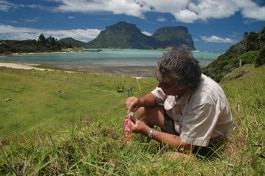
The Australian government can take a lot of credit for conservation efforts, including the designation of 75% of the island as parkland, instituting an island recycling program and more recently, launching a massive effort to address the increasing problem of ground water pollution due to the small human settlement of the island. A government program has provided each islander a remediation report and a clean-up prescription for his property. Finally, with its limit of 400 tourist beds and 15,000 tourists per year, the government tries to minimize the impact of humans on the island’s ecosystems.
Hutton is equally deserving of the credit to preserve this amazing place. “I see my role, and that of the island, to make people aware that the earth needs a steward.” And, that’s just what he has done. With ten books to his credit, his curatorial role at the island’s museum, his ongoing research of its unique flora and fauna, and his novel approach to ecotourism and island conservation, he is indeed a steward and a role model for us all.
Hutton is passionate about science and the environment. For 28 years he has conducted research in such diverse areas as seabirds, rare plants and endangered snails, and he has monitored climate change. In 1995 he set up bush regeneration ecotours on which tourists assist with weed eradication and conservation. He leads interpretative walks from the museum — walking the island with the scientists, eco-tourists and nature lovers who come every year to revel at the site of a beach where they’re likely to be one of just three people enjoying the surf. The tourists, 95% of whom are Australian, visit the island to scuba dive or see one of the rarest birds in the world, the wood hen. “People are blown away by nature when they come here,” says Hutton, noting that the tiny island boasts species of insects, plants and birds found nowhere else on the planet.
An accomplished photographer, Hutton’s work has been published in major newspapers and magazines worldwide, including The New York Times, Sydney Morning Herald and Melbourne Age. He has produced ten books on Lord Howe Island, the latest being a 264 page photo/art book celebrating the World Heritage values of the Island and stimulating interest in conservation in general.

In the News
The Power of Photography
It was a special presentation that earned a standing ovation. Attendees of National Geographic photographer Bob Caputo’s The Power of Photography, at the Stroud Water Research Center on March 11th, were moved by his colorful life story, extraordinarily beautiful photographs, and his palpable enthusiasm for his work — including his contribution to a Stroud education program, entitled Mountaintop to Tap. Reporters from The Daily Local, Lancaster Sunday News and the Pottstown Mercury News covered the event.
Learn more about the Mountaintop to Tap trek
Stroud Scientists and Educators Present
Disseminating Our Findings to our Peers and the Public at Large
Our ability to disseminate our findings to a broad audience allows us to increase awareness and create a public dialogue centered on the protection, preservation and restoration of watersheds everywhere. It’s for that reason that our scientists and educators engage in both scientific and public forums to share their findings. The following highlights recent presentations.
WATERSHEDS and FOODSHEDS
The Pennsylvania Association for Sustainable Agriculture (PASA) hosted its 18th annual Farming for the Future Conference this February in State College, PA. Its theme, The Worldwide Search for Food Sovereignty: Finding Your Foodshed, focused on the ability of communities anywhere to acquire their nutritional needs from local and regional production and processing networks, and how farmers could successfully tap into this trend. PASA’s annual conference has grown into one of the largest and most respected venues for farmers to learn about alternative agricultural strategies in the United States. It continues to draw thousands of attendees from across the U.S. and abroad. The keynote address, Watersheds as Foodsheds: When They are the Same, presented by Bern Sweeney, director of the Stroud Water Research Center, fit well with the thought-provoking reputation of the conference and underscored the links between our actions, the health of our watersheds — and the sustainability of our foodsheds.
THE FRESHWATER CRISIS
“It’s tough to convince people that there’s a freshwater crisis, when it’s raining outside,” said Bern Sweeney, director of the Stroud Water Research Center, but that was just what he attempted to do throughout the month of April, when spring showers were prevalent. Most people are unaware of how limited our worldwide supply of fresh water is — or their ability to directly impact both the quality and availability of that water. At the West Chester University (PA) Research Day, for an audience of faculty, students and their parents, and at the Rotary Club Mid-Atlantic District Conference held in Williamsburg, VA addressing the region’s business professionals, Sweeney outlined the severity of the crisis and what each of us can do about it.
STROUD SCIENTISTS PLAY A MAJOR ROLE AT NABS
Stroud scientists had a large presence at the 57th Annual Meeting of the North American Benthological Society (NABS) in Grand Rapids, Michigan in May. NABS, an international scientific organization whose purpose is to promote better understanding of lakes, streams and rivers hosts its annual meeting for the scientific community to disseminate new research results, interpretations and other information. At this meeting, Stroud scientists made the following presentations:
- Invertebrate and periphyton response to flow variability and managed flushing-flows in the Opuha and Opihi Rivers, New Zealand – Dave Arscott
- Algal contributions to suspended organic matter: A novel approach applied to the US great rivers and the Amazon – Anthony K. Aufdenkampe
- Hybridization and gene flow between two cryptic species in the Macaffertium modestum complex (Ephemeroptera: Heptageniidae) – David H. Funk
- The spiral does not end with uptake: The turnover length may be more important than we thought – J. Denis Newbold
- Macroinvertebrate assessment of water quality in White Clay Creek based on specimens identified by amateurs, professionals, and barcoding – Bernard W. Sweeney
TREES FOR OUR CITIES, PARKS, STREAMS AND PLANET
As part of the 7th annual Pennsylvania Land Conservation Conference in State College, PA, Bern Sweeney, director of the Stroud Water Research Center, addressed a seminar audience for those involved with private and public land conservation. The seminar entitled, Trees for Our Cities, Parks, Streams and Planet: Strategies for a Healthier Penn’s Woods, demonstrated the value of streamside forests to both our watersheds and the communities they serve, because of their ability to reduce the amount of pollutants that enter a stream.
In addition, Sweeney addressed an audience of Lancaster County, PA politicians and conservation workers as part of a Chesapeake Bay Foundation-sponsored workshop on streamside forests on April 3rd. Sweeney’s talk entitled, Forest Buffers, the Stream Ecosystem, and Water Quality: What is the Science Telling Us?, was a primer on both the value of streamside forests and how to successfully fund them through state-run programs. Sweeney also discussed the Center’s ambitious proposal to restore the streamside forest buffer along all of White Clay Creek which would impact the 120,000 individuals who rely on the creek for drinking water; the proposal, which was submitted to the National Oceanic and Atmospheric Administration, is now under review.
THE RAIN BARREL PROJECT
“Even small measures taken by individuals can help to reduce the impacts of urban runoff,” said Stroud education programs manager, Vivian Williams, as she began to convey the methods homeowners and businesses could use to reduce stormwater runoff, at one of several public presentations in Pennsylvania which were part of a multipart program called The Rain Barrel Project. The project, which was supported in part by funds from the Consortium for Scientific Assistance to Watersheds (C-SAW), and developed by Stroud Water Research Center in partnership with Media Borough and the Media Environmental Advisory Council of Pennsylvania, targeted both children and adults.
Students from Nativity BVM, Media Elementary, and Media Providence Friends School learned about the problems of stormwater runoff and how that water affects their schools, neighborhoods and local streams. Based on what they learned, they then created and applied their designs to 133 gallon rain barrels that were ultimately installed at school sites and in public spaces throughout Media Borough, including the local library.
FISH AND WATER QUALITY
Bern Sweeney, director of the Stroud Water Research Center, delivered the keynote to 125 fishery resource specialists, ecologists and managers from government agencies and academic institutions of the Northeast at the The Fish & Wildlife Conference in Lancaster, Pennsylvania, on April 26th. Sweeney discussed the lessons learned about water quality classifications in Pennsylvania based on macroinvertebrates, and the states designations based on fish communities. Said Sweeney, “The bottom line is that the two systems of stream classifications were not always consistent; some streams assigned as Cold Water Fisheries (the highest fish category) were categorized as having poor water quality based on macroinvertebrates.”
Willy Eldridge attended the Annual Meeting of the NY & PA Sections of the American Fisheries Society in Owego, NY during the month of February where he presented, Effect of rate of change during diel (24-hour) temperature fluctuations on growth, stress and pathology of seven warm water fish species.


